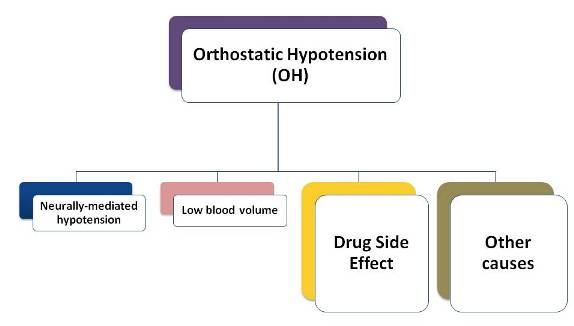Orthostatic Hypotension Due to Drugs and Other Causes
Orthostatic Hypotension (OH) [or a drop in the blood pressure when the person stands up with orthostatic symptoms, such as dizziness, lightheadedness, changes in vision, and/or weakness] can be caused by drugs and other things.
These other causes can also make orthostatic hypotension from low blood volume or NMH worse.

Orthostatic symptoms with orthostatic hypotension (a drop in blood pressure) can occur with these:
- Prolonged bedrest - If a person has been on prolonged bedrest, they might have orthostatic symptoms when they stand up7. If the bedrest has been shorter than 4 weeks, the symptoms should get better as the person gets back to normal activities. It is taught that for every 1 day of bedrest, it takes 5 days to recover. For more about bedrest and orthostatic symptoms, go to Bedrest, Bedrest and OI or Bedrest: Space flight and ICU-stays.
- Drug related: side effect of drug. This is a very common cause of orthostatic hypotension especially in older people. For a list of drugs, go to Drugs With Orthostatic Side Effects
- Pregnancy
- Addison’s disease (usually volume depletion)8
- Atherosclerosis ('hardening of the arteries' – It changes the arteries and makes it difficult for them to adapt quickly to changing position.
- Increasing age. In some reports, OH itself is more common in very old people2. It is related the types of medical problems a person has and the medications they take to manage them. With the older people, the blood pressure lying down is often high.
About 20% of people over 65 have been reported to have their systolic blood pressure go down more than 20 mm Hg when they stood up. In another study, 18% of people over age 60 had symptoms of dizziness that was severe enough to interfere with their activities of daily lives.6
 Orthostatic Hypotension (OH):
Orthostatic Hypotension (OH):What is OH?
Criteria to diagnose OH
What is NMH?
OH due to low blood volume
OH due to drugs & other causes
Next Topics To Review
Causes of OI
Deconditioning
Getting Medical Care
Taking Care - Everyday Self-Care
References
- Moya, Guidelines for the diagnosis and management of syncope (version 2009). European Heart Journal (2009); 30: 2631-2671. Abstract. Article PDF.
- Freeman, Roy. Neurogenic orthostatic hypotension.NEJM 2008;358(6):615-624. Abstract
- Figueroa JJ, Basford JR, Low PA. Preventing and treating orthostatic hypotension: As easy as A, B, C. Cleve Clin J Med. 2010 May;77(5):298-306. Abstract. Article PDF.
- Wedro, Benjamin, Stoppler, Mellissa. Orthostatic hypotension. MedicineNet. Last accessed: June 24, 2012. Article"
- Brignole, M. The syndromes of orthostatic intolerance. E-journal of Cardiology Practice. 2007: 6(5). Access. http://www.escardio.org/communities/councils/ccp/e-journal/volume6/Pages/vol6n5.aspx
- Medow MS, Stewart JM, Sanyal S, Mumtaz A, Stca D and Frishman WH. Pathophysiology, Diagnosis, and Treatment of Orthostatic Hypotension and Vasovagal Syncope. Cardiology in Review 2008;16(1):4-20. Abstract.
- Winkelman, Chris RN, PhD, CCRN ACNP. Bed Rest in Health and Critical Illness: A Body Systems Approach. AACN Advanced Critical Care: 2009; 20(3); 254-266. Abstract.
- Brignole M. Diagnosis and Treatment of Syncope. Heart 2007: 93; 130-136. Article PDF
- Sukul D, Chelimsky TC, Chelimsky G. Pediatric autonomic testing: retrospective review of a large series.Clin Pediatr (Phila). 2012 Jan;51(1):17-22. doi: 10.1177/0009922811415102. Epub 2011 Aug 25. Abstract.
Author: Kay E. Jewell, MD
Page Last Updated: September 9, 2012
